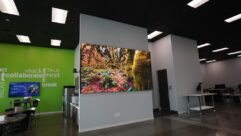All things invisible: At L.A.’s IdeaHouse, advanced multimedia capabilitiesare enclosed within wall, hidden in cabinets and lurking behind secretpanels.
Aug 1, 1997 12:00 PM,
Gregory A. DeTogne
Meet Sarah and Philip, and welcome to their country cottage. Sarah is alandscape architect who works at home (lives at work is probably more likeit). Philip, her fast-track husband, is a lawyer specializing inentertainment law. Together they share a 4,000 ft2 (372 m2) bungalowtypical of those found in Santa Monica. Their lifestyle expresses goodfortune with sophisticated, yet functional taste.
Please, come inside. It’s a pleasure having you. There’s more than $1million worth of household furnishings and products to captivate yoursenses with muted elegance. Wine chills in a bucket of ice as moody strainsof jazz magically float through the air from an unseen source. The terraceis a private sanctuary veiled by plant life.
Yet for everything in full view, there is just as much to say about thatwhich is unseen. For it is here in the shadows, enclosed within walls,hidden in cabinets and lurking behind secret panels, that the home’sadvanced multimedia capabilities await their cues to spring into action.
And while you may not be able to readily discern where the componentscomprising the home theater system are, Sarah and Philip are up-front aboutone thing: Virtually anyone is welcome to stop in anytime during regularbusiness hours. In fact, Sarah and Philip are so accommodating that theydon’t even have a front door. Nada. Zip. No trace of a hinge even. It’s asif their house were a show room
Well, it is. No matter how hard you look, you won’t find Sarah and Philiplounging about either, because they don’t exist. They are merely fictionalbeings hatched by designer Joe Ruggiero, the man responsible for creatingtheir showcase home, which is part of the Pacific Design Center in WestHollywood.
As functioning proof that multimedia home systems can aesthetically coexistwith contemporary interior architecture, the Los Angeles IdeaHouse is athree-dimensional design resource where architects, designers and privatehomeowners are able to explore a working repository of stylish homeproducts ranging from fabrics and fine furniture to the latest in hometheater systems. Compared to traditional show rooms, the IdeaHouse providesan extra ingredient that the former cannot: an opportunity to view andinteract with products and technology under actual living conditions.
Ruggiero has opened other IdeaHouses in San Francisco, Dallas and Seattleand is creator of several programs regularly seen on cable’s Home andGarden Television station.
“The whole thing with new technology is invisibility. It’s trying to getrid of it,” he has said when asked about multimedia integration within hisinterior designs. To meet this goal, Ruggiero joined forces on this projectwith Jon M. Edwards, a multimedia systems integrator and designer whosefirm, Sunset Studios, is coincidentally located in the same building as theIdeaHouse.
One of the pioneers of home systems integration, Edwards gainedprofessional distinction in a roundabout fashion. As a producer of visualeffects in the prehistoric days of computergraphics, he began renting hisown 35 mm screening room to others when he wasn’t using it himself. Inkeeping the room technologically up-to-date, he developed and fine-tunedhis design skills and went on to create turnkey multimedia systems forothers on corporate and residential levels.
If there’s a moral to his story, it’s probably that the most prevalentcommon denominator he has found between all the manufacturers of multimediatechnology is confusion. As he sees it, that’s caused by the breakneck pacewith which the field of electronic communications and home multimedia areevolving. As a result, few manufacturers have had time to develop theexpertise required to successfully marry their technologies with that ofothers. Included in this group are designers and builders of wide-bandtelecommunications equipment, loudspeakers, surround sound components,amplifiers, projectors, multisync generators and computer gear.
In helping to lift this often complicated cloud of perplexity, Edwardsviews his role as one which should ideally free his clients from evenhaving to think about technology. He is the one who makes it all work.Reliably, and with no excuses.
Edwards has worked with telecommunications services such as Pacific Bell,as well as with manufacturers of video and audio electronics, such asAngstrom, Rane, Hafler, Tannoy, AMX, NEC, Parasound, Multiplex Technology,Extron Electronics and Sound Advance Systems.
Beyond his flair for making disparate elements work with and talk to oneanother on an ongoing basis, he is also a master of visual deceit. To wit:his L.A. IdeaHouse design serves as a technical disappearing act worthy ofAgent 007 himself. A computer screen glides out of a secret place withinthe furniture with a push of a button. Platforms materialize from nowhereto reveal TV monitors or projection screens. The ethereal horn of MilesDavis enters your ear from loudspeakers residing completely out-of-sightwithin the walls themselves.
“Working on their fictional behalf, I made Sarah and Philip’s technicaldesign choices in a fashion which reflects life and work in the ’90s,”Edwards says of his IdeaHouse schematic. “It’s an environment wheregraceful interior design and high technology coexist: video and audioequipment blends subtly or even disappears into its surroundings. It is ahome for independently employed people in demanding, creative professions.At the same time, it’s also a habitat for the fastpaced world of virtualoffices, on-line communications, video teleconferencing and entertainment.”
On the entertainment end of the spectrum, Sarah and Philip’s home theaterserves as their design centerpiece. A high-tech lovefest outfitted withhigh-definition, large-screen projection video and audiophile-quality soundreinforcement, the room allows visitors to view the first wireless digitalbroadcast television in the United States, courtesy of Pacific Bell FasTrakData and Video Services and Pacific Bell Digital TV. With more than 150channels and CD-like audio, the digital wireless television is outfittedwith tremendous interactive capabilities which, with just a few keystrokeson a handheld remote, automatically program the VCR and indicate generalprogramming information for future dates as well as those past, allaccording to viewers’ tastes and preferences.
For the hardcore technoid, here’s a quick body count of the unseen gadgetrythat brings the 12×14 home theater to life: Hafler Transnova amplifierscombine with Tannoy studio monitors to deliver sound-for-picture to aStewart Filmscreen screen, using Rane THX equalization and a hi-po surroundsound pre-amp decoder called the Media Director from Angstrom. NECmultisync video projector technology allows both computer presentations andtelevision signals to be broadcast using the same projector. To ease thegrowing pains of adapting to the future, Edwards’ choice of the NECprojector thoughtfully leaves space for the incorporation of linemultipliers for improved definition, as well as the true HDTV gear thatpromises to cross our thresholds in not-too-distant days.
Push a few buttons in the theater and automatic blinds from SM Automaticwill open or close, as will the Makitacontrolled automatic drapes. Sonancesupplied the switching components; high-resolution cable and interconnectsfrom Kimber-Kable tie it all together. Standing as silent sentinels oversystem operations are Panamax surge protectors and AC power controllers.
Should he indeed ever exist, the imaginary Philip will find the theater’s45-270 megabit per second fiber-optic network, also from Pacific Bell,especially advantageous for receiving and transmitting broadcast-qualityvideo. With this technology, entertainment industry types could viewdailies without traveling to a studio screening room. Or receive clientinput on editing tasks being performed, even at great distances. Cool, huh?
Back out in Sarah and Philip’s living room, Edwards designed and installeda smaller home theater environment centered around an RCA/Proscan TVmonitor, which rises on cue out of a piece of furniture. Served by arackful of equipment hidden in another room, this multimedia system ispowered by a Lexicon CP3 surround-sound pre-amp used in conjunction withRane SSA6 multichannel amplification and THX equalization. When the buttonis pushed to make the TV monitor materialize, it automatically switches ahousehold music system off and directs audio signals via a Sonance MRC100two-zone pre-amp to Tannoy’s Definition Series home theater systemloudspeakers.
The housewide music system is served in both the living room and the masterbedroom suite by SA2 loudspeakers from Sound Advance Systems. Flat-panel or”planar” in design, the SA2s vanish into the walls without a trace. Theyhave become, literally, part of the woodwork. Er, drywall — you know whatI mean. As such, they use the walls themselves as part of their radiatingsurface to provide true audiophile performance in wide, evenly dispersedpatterns. They can be painted or wallpapered over and are equipped withprotective circuitry as a safeguard against mechanical or thermal overload.If they go south after becoming part of your house’s infrastructure for anyreason, the manufacturer’s guarantee provides for both replacement of theloudspeaker and the wall (read: they don’t fail).
“The SA2s have been one of the standout items for many visitors to Sarahand Philip’s country cottage,” notes Edwards. “This technology has beenaround for a while, but few have known of it. Once interior designers, wholive and breathe to keep things minimalist and hidden, found out aboutthem, love blossomed. This whole situation is a perfect example of how theIdeaHouse’s outreach capabilities work. Real market development results canand do occur.”
As another mindful complement to system integration, Edwards and PacificBell were able to bring a variety of Internet, videoconferencing andteleconferencing services to the IdeaHouse. High-speed ISDN lines maketraditional Internet modem access seem like the work of snails on Xanax,while teleconferencing and videoconferencing are as easy as pressing a fewmore buttons in the theater and enlisting the powers of a ShureConferencePhone.
To accommodate some of the changes tomorrow is sure to bring, Edwards chosea Smart Home cabling system provided by Smart cable, which allowed him toprovide an unprecedented level of preparation to accommodate theIdeaHouse’s multimedia future. Outfitted in a single jacket with multiplecables for use with low-voltage signals from telephone companies, cable TVproviders and utility companies, Smart cable systems come with a baseinterconnect panel that can easily be modified as residential needs undergothe natural process of technical metamorphosis.
Edwards’ overall design is based on a personal philosophy that afundamental transformation is taking place in TV broadcast and in the waysin which we relate to television and multimedia. “Things are changing sofast that you have to incorporate an extremely open and flexiblearchitecture to compensate for what tomorrow is sure to bring,” heexplains. “The L.A. IdeaHouse was created in large part to explore thetransformations currently underway. Television is no longer just a passiveviewing object. It is rapidly becoming a springboard into the world ofinteractive media. What you see and hear at the IdeaHouse is all availableright now; there’s no vaporware. But I’ve also left a lot of room for nextweek. The 21st century is only a few years away, and with this system,Sarah and Philip can make the transition without feeling the pains ofobsolescence.”
The L.A. IdeaHouse is full of great technology. But can the end-user accessitEven hardcore Luddites have to admit that two positive things can be saidabout technology these days: It’s getting smarter and easier to use.
Need proof OK, on a consumer level, consider that you don’t even have toprogram most VCR clocks anymore. They manage that task all by themselves,and even know the correct time. The really clever ones make automaticadjustments for changes between savings and standard time too. Now that’ssmarter.
As for ease-of-use issues, consider that today the average American onlyhas about seven separate remote control devices to run all of theelectronic components within the household. That’s down from approximately12 a scant six years ago.
Within our professional world, designer Jon Edwards has done his part tosimplify technology by making the L.A. IdeaHouse as user-friendly assigning on line 10 and letting the IRS figure the rest of your taxes.
“In the dedicated media room, we’re using an AMX Accent mini-system with anactive color matrix touch-screen user interface,” he reveals. “It controlsall the various media system components from a single source and was usedto create macros, which automate the blinds and drapes as well.”
Throughout the rest of the house, Edwards brought more end-user relief viaan RCK-8 LCD universal touch-screen remote control from Knoll Systems andan IR repeater system. With a combined retail price for both running lessthan $500 U.S., Edwards’ controlling configuration permits a singlehandheld IR remote to trigger lighting presets on a Lutron Graphic Eyesystem as well as the lifts which bring a computer desk and TV cabinet outof hiding.








